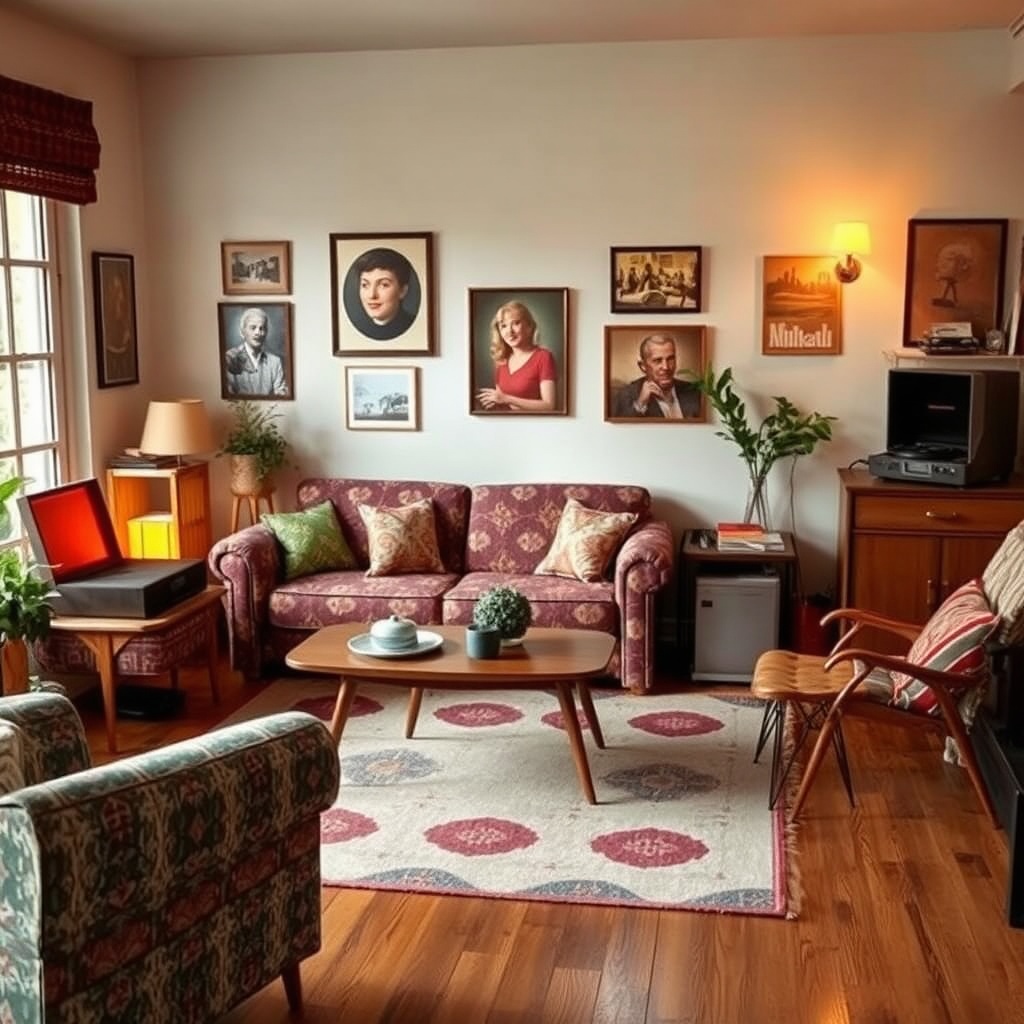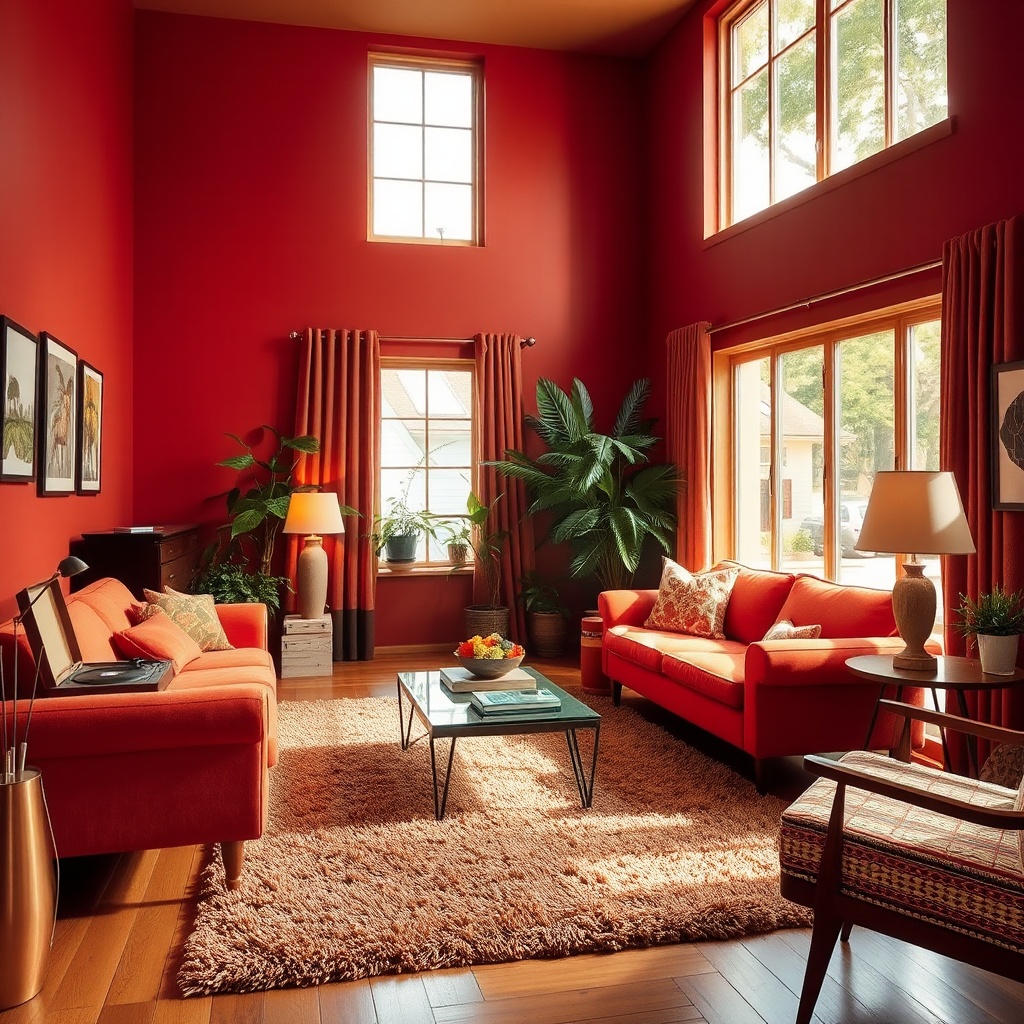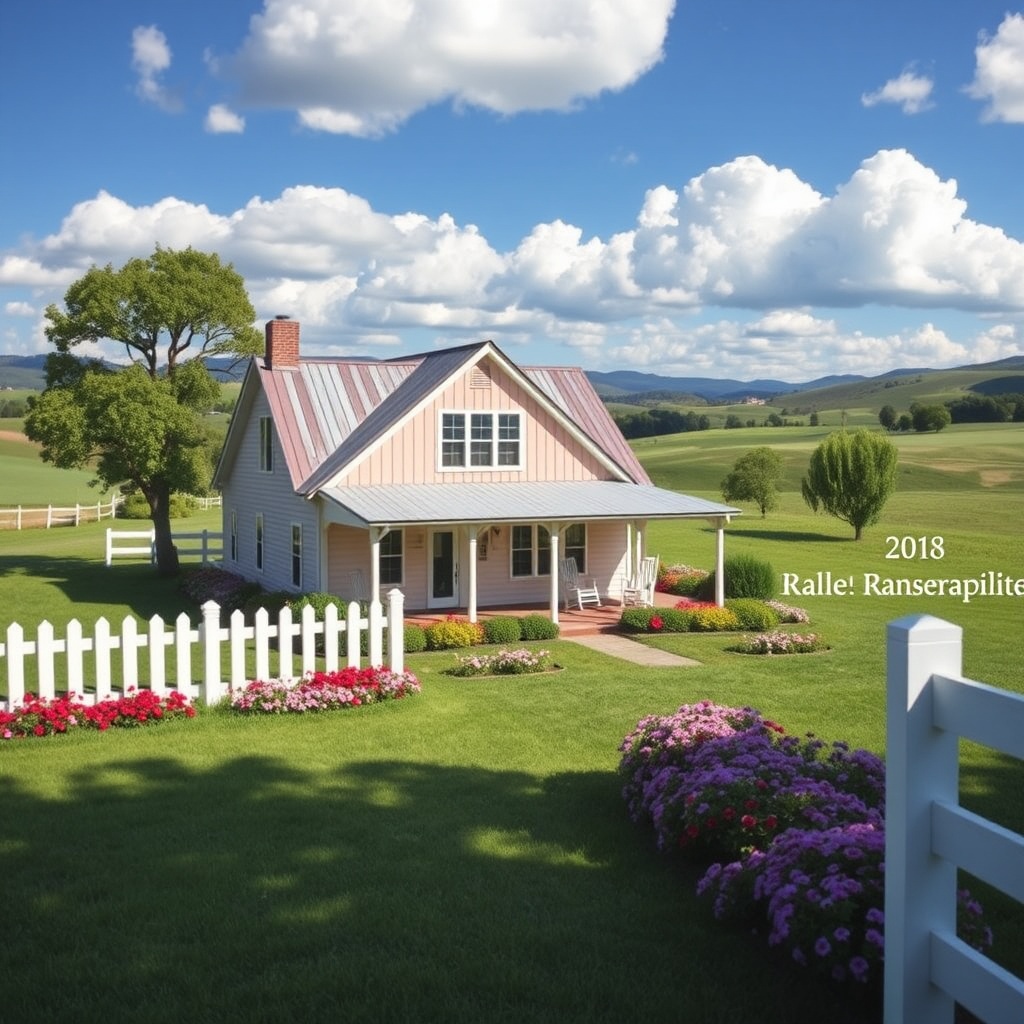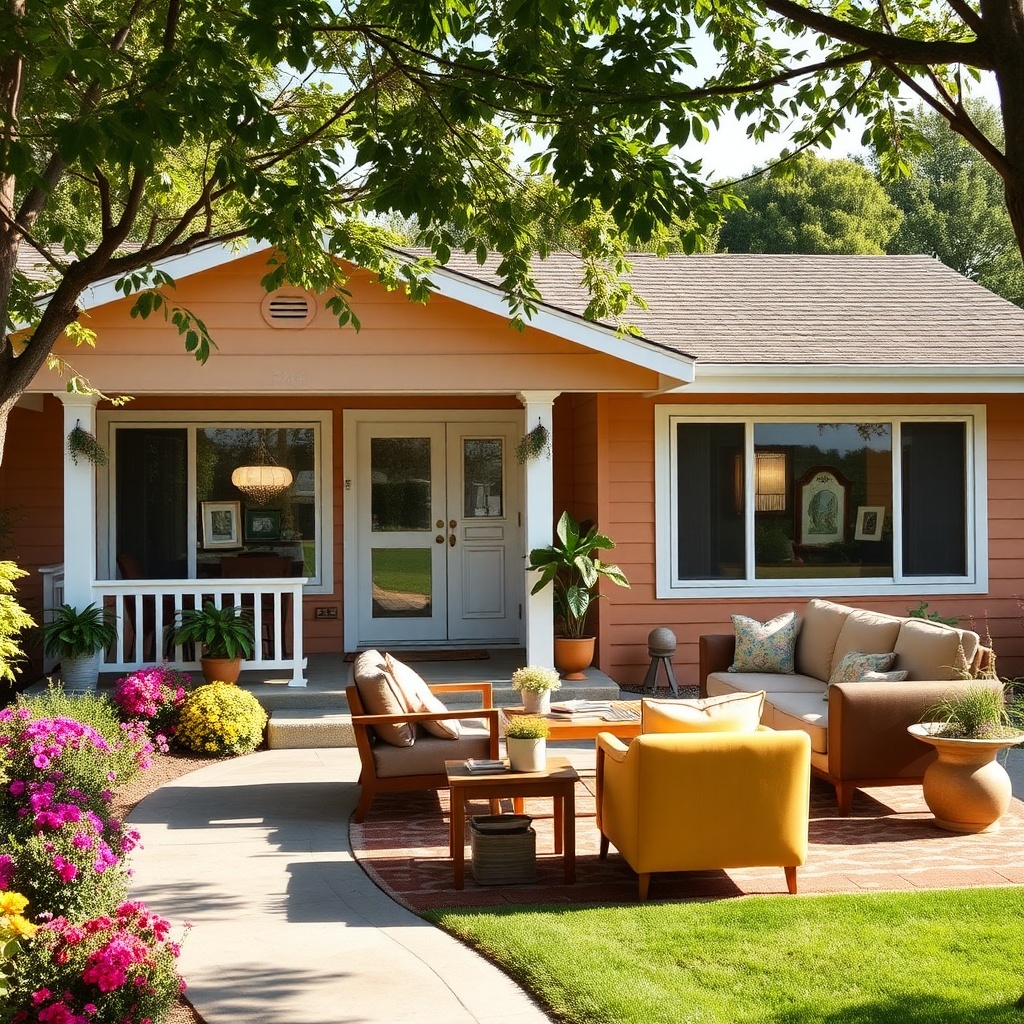Embrace the Past: Infusing 1960s Charm into Your Modern Sanctuary

Are you ready to transform your beloved 1960s ranch into a modern sanctuary while preserving its unique charm? This interactive guide will lead you through the steps to embrace the past and infuse your home with timeless features that celebrate your history.
Understanding the 1960s Aesthetic
The 1960s was a decade defined by bold colors, organic shapes, and a connection to nature. Here are some key elements:
- Color Palette: Think earthy tones, vibrant oranges, and avocado greens.
- Materials: Wood paneling, brick, and stone were popular.
- Furniture Style: Low-slung sofas, modular designs, and retro patterns.
Interactive Step-by-Step Transformation
Let’s dive into the process of revitalizing your ranch!
Step 1: Assess Your Space
Evaluate your current layout and identify what you love about it. Consider:
- What original features can be preserved?
- Which rooms need a refresh?
Step 2: Choose a Color Scheme
Once you have assessed your space, it’s time to choose a color scheme. Engage with your emotions:
- What colors make you feel nostalgic?
- Which shades can complement modern decor?
Step 3: Incorporate Vintage Furniture
Seek out vintage furniture pieces that resonate with the 1960s style:
- Consider thrift stores or online marketplaces.
- Mix in modern pieces to create a balanced aesthetic.
Step 4: Update Fixtures and Accessories
Enhance your space with the right fixtures and accessories:
- Install retro light fixtures and ceiling fans.
- Add bold graphic prints through cushions and rugs.
Step 5: Create a Garden Oasis
Don’t forget the outdoor space! A garden can reflect the 1960s connection to nature:
- Plant native flowers and shrubs.
- Design a cozy seating area for relaxation.
Final Touches
As you complete your transformation, remember to:
- Keep personal touches that tell your story.
- Invite friends and family to enjoy your modern sanctuary.
Revitalizing your 1960s ranch is not just about making it modern; it’s about celebrating its history. By following these steps, you can create a harmonious blend of past and present that enhances your living experience.
Step Inside: Creating Inviting Spaces That Echo the Elegance of the 60s

Imagine stepping through the door of your 1960s ranch home and feeling a wave of nostalgia while also appreciating the modern comforts that enhance your living space. It’s about harmonizing the charm of the past with the practicality of today. Let’s explore how you can create inviting spaces that resonate with the elegance of the 60s.
1. Embrace Open Spaces
The 1960s ranch style is known for its open floor plans. To revive this, consider:
- Removing unnecessary walls to enhance flow and connectivity.
- Incorporating large windows for natural light and views of your garden.
- Using furniture arrangements that promote conversation and interaction.
2. Choose a Color Palette Inspired by the Era
Colors from the 60s were bold yet harmonious. Think about:
- Earthy tones such as olive green, mustard yellow, and burnt orange.
- Accent colors like teal or coral to add vibrancy.
- Soft pastels for a calming effect in bedrooms.
3. Furnish with Purpose
When selecting furniture, look for pieces that reflect the 60s style:
- Mid-century modern furniture with clean lines and organic shapes.
- Textured fabrics such as velvet or tweed for comfort and style.
- Statement pieces like a retro coffee table or a vintage armchair.
4. Add Vintage Touches
To evoke a sense of nostalgia, consider incorporating vintage elements:
- Retro light fixtures that serve as focal points in your rooms.
- Classic artwork or posters from the 60s to adorn your walls.
- Collectibles such as vinyl records or antiques displayed on shelves.
5. Create Cozy Nooks
Designing cozy spaces encourages relaxation and connection:
- Reading corners with comfortable chairs and good lighting.
- Breakfast nooks with sunlit views for morning coffee.
- Outdoor seating that invites gatherings in the garden.
6. Focus on Functionality
Modern living requires practicality:
- Smart storage solutions to reduce clutter.
- Accessible layouts that accommodate mobility needs.
- Energy-efficient appliances that blend with vintage aesthetics.
Creating inviting spaces in your 1960s ranch home is about honoring the past while making room for contemporary life. By embracing the elegance of the 60s with thoughtful design choices, you can craft a home that feels warm, welcoming, and uniquely yours. Ready to take the plunge into a stylish transformation that respects your roots? Let’s bring the timeless elegance of the 60s into your modern living experience.
From Drab to Fab: Transforming Your Ranch with Vibrant Color Palettes

Understanding the Power of Color
Colors have a profound impact on our emotions and can greatly affect the atmosphere of your home. By choosing the right color palette, you can easily breathe new life into the tired spaces of your 1960s ranch.
Step 1: Evaluating Your Current Space
Before diving into color selection, take a moment to evaluate your current surroundings. Ask yourself:
What colors currently dominate the space?
Which areas feel dull or uninviting?
What mood do you want to create?
Step 2: Choosing a Color Palette
Now that you have an understanding of your space, it’s time to explore color palettes that can transform your ranch:
| Color Palette | Description |
|---|---|
| Retro Revival | Incorporate vibrant yellows, oranges, and greens reminiscent of the 1960s for a nostalgic feel. |
| Earthy Elegance | Choose warm browns, muted oranges, and deep greens to create a cozy, inviting atmosphere. |
| Cool Coastal | Light blues, sandy beiges, and crisp whites evoke a refreshing seaside vibe. |
| Modern Minimalist | Opt for soft greys, whites, and pastels for a clean, contemporary look. |
Step 3: Applying Your Color Palette
With your palette chosen, it’s time to apply these colors throughout your ranch. Here are some ideas to get you started:
Accent Walls: Paint one wall in a bold color to create a focal point in your living room or bedroom.
Furniture: Consider reupholstering old furniture in vibrant fabrics that align with your chosen palette.
Accessories: Use colorful cushions, rugs, and artwork to tie the entire look together.
Step 4: Engaging Family and Friends
Transforming your ranch can be a fun project to share with loved ones. Invite family and friends to join you:
Host a color selection party where everyone can contribute their ideas.
Plan a painting day, turning the task into a memorable gathering.
Step 5: Enjoying Your Revitalized Space
After the hard work is done, take a moment to enjoy your transformed home. Consider:
How do the new colors make you feel?
What changes have improved the atmosphere of your ranch?
Embrace the vibrant new look of your 1960s ranch and celebrate your creativity!
Nostalgic Touches: Incorporating Iconic 60s Decor for a Classic Feel
Embrace the 60s Aesthetic
The 1960s was a decade of bold colors, unique patterns, and innovative designs. To bring those nostalgic touches into your home, consider the following elements:
Bold Color Palettes
Imagine vibrant oranges, yellows, and greens filling your space. Consider painting an accent wall in a bright hue to create a lively atmosphere. Pair this with muted furniture to balance the brightness.
Patterned Fabrics
Retro patterns were everywhere in the 60s. Look for fabrics with geometric shapes, florals, or psychedelic prints. You can reupholster your furniture or add throw pillows to introduce these patterns seamlessly.
Classic Furniture Pieces
Invest in furniture that speaks to the era. Mid-century modern pieces are iconic for a reason! Think about low-slung sofas, teak wood sideboards, and minimalist coffee tables. These elements will give your home that authentic 60s vibe.
Art and Accessories
Artwork from the 60s often features abstract designs and vibrant colors. Try to find original pieces or prints that capture the spirit of the time. Hang them on your walls to create a gallery wall that tells a story.
Lighting Fixtures
Lighting is crucial for setting the mood. Look for pendant lights or table lamps with unique designs that were popular in the 60s. A classic globe or a funky arc lamp can become a statement piece in your living room.
Incorporating Technology
While it’s important to maintain a nostalgic feel, integrating modern technology is essential for comfort. Choose retro-styled appliances that blend seamlessly with your decor. For instance, a vintage-style refrigerator can add character while providing modern efficiency.
Accessorize with small items like vintage clocks, record players, or throw blankets that reflect the 60s. These little details can pull your entire look together and create a cozy, inviting space.
Engaging with these nostalgic elements can create a home that not only honors the past but also meets modern living needs. Happy decorating!
A Seamless Blend: Merging Modern Convenience with Retro Aesthetics
Understanding the 1960s Ranch Style
The 1960s ranch style is characterized by its open floor plans, large windows, and low-profile design. Embrace the charm of this architectural era while incorporating modern conveniences that enhance your living experience.
Key Elements to Retain
As you embark on your revitalization journey, consider keeping these iconic features:
Low-pitched rooflines
Wide eaves that provide shade and keep your home cool
Natural materials such as wood and stone for a classic feel
Modern Upgrades to Consider
Now, let’s explore some modern upgrades that can be seamlessly integrated:
Smart Home Technology: Introduce devices that can be controlled from your smartphone or voice assistant, enhancing comfort without compromising aesthetics.
Energy-efficient windows: Replace old windows with modern, energy-efficient options that maintain the retro look while improving insulation.
Open-concept living: If your space allows, consider knocking down non-load-bearing walls to create a more spacious feel.
Choosing the Right Color Palette
To achieve a retro vibe while still being modern, opt for a color palette that reflects the 1960s:
Soft pastels like mint green or peach
Bold accents in mustard yellow or teal
Neutrals such as beige or light gray to balance vibrant colors
Furnishing Your Space
When selecting furniture, look for pieces that showcase mid-century modern design:
Low-profile sofas with tapered legs
Iconic chairs like the Eames lounge chair
Wooden coffee tables with clean lines
Final Touches: Accessories and Decor
Accessorizing is crucial. Incorporate items that reflect the 1960s aesthetic:
Retro light fixtures such as Sputnik chandeliers
Vintage art pieces or prints that highlight the era
Indoor plants in colorful pots to add life
Interactive Spaces
Engage with your living area by creating interactive zones within your home:
Reading nook: A cozy corner with a comfortable chair and good lighting
Game area: A small table for board games or puzzles, encouraging family interaction
Garden access: A seamless transition from indoors to outdoors, fostering connection with nature
Revitalizing your 1960s ranch can be a fulfilling project that honors the past while embracing the future. By merging modern convenience with retro aesthetics, you can create a space that is both comfortable and stylish, making it ideal for modern living.
Gardens of Yesteryear: Reviving 1960s Landscaping for Today’s Lifestyle
Rediscovering the Charm of 1960s Gardens
The 1960s were a time of vibrant, eclectic gardens that reflected the spirit of the era. Have you ever wondered how to bring back that wonderful charm while still catering to modern needs? Let’s explore ways to breathe new life into your outdoor spaces!
Key Features of 1960s Landscaping
To begin your transformation, recall the key elements that made 1960s gardens unique:
- Bold Colors: Bright, vivid flowers and foliage.
- Functional Spaces: Areas designed for leisure, such as patios and seating.
- Native Plants: Utilizing local flora for ease of maintenance.
- Mixed Textures: A combination of grass, stones, and plants.
Steps to Revive Your 1960s Garden
Follow these steps to create a garden that pays homage to the past while fitting seamlessly into today’s lifestyle:
- Evaluate Your Space: Look at your current garden layout. What features from the 1960s can be resurrected? Think about open spaces and how they can be optimized.
- Choose the Right Plants: Select a mix of perennials and annuals that offer vibrant colors and textures. Consider plants like daylilies, coneflowers, and asters for a nostalgic feel.
- Incorporate Seating Areas: Design cozy nooks with comfortable chairs or benches. Use materials that reflect the era, such as wrought iron or wood.
- Add Pathways: Create meandering paths with gravel or stepping stones, allowing easy navigation through your garden.
- Include Water Features: A small fountain or pond can add tranquility and a touch of elegance, reminiscent of the 1960s gardens.
Modern Touches to Consider
While reviving the past, it’s also important to integrate modern elements:
- Sustainable Practices: Opt for eco-friendly materials and native plants to reduce maintenance.
- Smart Technology: Consider automated watering systems to ease upkeep.
- Accessibility Features: Ensure paths and seating areas are easily accessible for all, including those with mobility challenges.
Engaging with Your Garden
Gardening is not just about aesthetics; it’s also about engagement. Here are some interactive ideas to enhance your experience:
- Garden Workshops: Host workshops for neighbors or friends to share gardening tips and techniques.
- Plant Swap Events: Organize a plant exchange to diversify your garden and connect with fellow gardening enthusiasts.
- Seasonal Gatherings: Use your garden as a gathering place, inviting family and friends for seasonal picnics or tea parties.
Final Thoughts
Reviving your 1960s garden is a delightful journey that combines nostalgia with modern living. By embracing the essence of the past while making thoughtful updates, you can create a space that is both functional and beautiful. Ready to get started? Your garden awaits!
Sustainable Living: Retro Renovations that Honor the Earth
Embrace Sustainable Practices
As you embark on the journey of renovating your 1960s ranch, consider adopting sustainable practices that not only enhance your home but also contribute positively to the environment. Here are some ideas to inspire you:
- Energy-efficient appliances: Upgrade to modern appliances that consume less energy. Look for those with Energy Star ratings for optimal efficiency.
- Solar panels: Harness the power of the sun by installing solar panels. These can significantly reduce your electricity bills and carbon footprint.
- Rainwater harvesting: Consider installing a rainwater collection system. This can be used for irrigation or flushing toilets, reducing water consumption.
Preserve Retro Features
While modernizing your space, it’s important to preserve the unique features that define the 1960s aesthetic. Here are some elements to keep in mind:
- Mid-century modern furniture: Seek out vintage pieces that can be restored rather than replaced. This honors the era while reducing waste.
- Original flooring: If your home has hardwood floors, consider refinishing them instead of replacing them. This maintains the charm and reduces landfill waste.
- Classic color palettes: Embrace the iconic colors of the 1960s, such as avocado green and harvest gold, in your renovations. These colors can be used in paint, tiles, or accessories.
Incorporate Eco-friendly Materials
Choosing the right materials is essential for a sustainable renovation. Here are some eco-friendly options:
- Bamboo flooring: A highly renewable resource, bamboo is a great alternative to traditional hardwood.
- Recycled materials: Use reclaimed wood, recycled glass, or metal to add unique touches to your renovation.
- Low-VOC paints: Opt for paints and finishes that have low volatile organic compounds (VOCs) to improve indoor air quality.
Engage with Nature
Integrating nature into your home promotes sustainability and enhances your living experience. Consider the following:
- Native landscaping: Plant native plants in your garden. They require less water and are better for local wildlife.
- Outdoor living spaces: Create spaces that allow you to enjoy your garden, such as patios or decks made from sustainable materials.
- Indoor plants: Adding houseplants can improve air quality and bring a touch of nature indoors.
Get Involved and Educate
As you renovate, consider sharing your journey with others. Engage with the community by:
- Hosting workshops: Share your knowledge on sustainable living through workshops or community events.
- Volunteering: Get involved with local organizations focused on sustainability and retro renovations.
- Documenting your process: Create a blog or social media account to inspire others with your sustainable renovation journey.
Revitalizing your 1960s ranch can be a fulfilling project that honors the past while embracing a sustainable future. By making thoughtful choices, you can create a home that is not only beautiful but also kind to the Earth.
Heart of the Home: Designing a Kitchen that Celebrates 60s Family Gatherings
Embrace the Nostalgia
Imagine walking into your kitchen and feeling the warmth of family gatherings from the 1960s. The kitchen was not just a place for cooking; it was where stories were shared, and memories were made. To revitalize your 1960s ranch kitchen, let’s explore how to recreate that inviting atmosphere while incorporating modern conveniences.
Open Layouts for Connection
Open-concept kitchens were popular in the 60s, allowing families to connect while preparing meals. To achieve this, consider removing unnecessary walls to create a spacious, inviting environment. This not only enhances the flow of the home but also encourages interaction during meal prep.
Iconic Color Schemes
Colors were vibrant in the 60s. Think about incorporating bold hues or earthy tones reminiscent of that era. Shades like avocado green, mustard yellow, or a classic turquoise can be paired with modern finishes to keep the aesthetic fresh. Use these colors for cabinetry or backsplashes, creating a beautiful focal point.
Timeless Appliances
While modern appliances are essential, you can select options that nod to the past. Look for retro-styled appliances that offer modern functionality with a vintage flair. Brands often design products that evoke nostalgia while being energy-efficient, making them perfect for today’s lifestyle.
Gathering Spaces
A kitchen island or a cozy breakfast nook can be a fantastic addition. This creates a space for family members to gather, much like the dining tables of the 60s. Consider adding seating that encourages conversation—perhaps with stools that have a retro vibe.
Textured Surfaces
Incorporate textures to enhance the kitchen’s charm. Use natural materials like wood or stone for countertops and cabinetry. A butcher block island or reclaimed wood shelves can bring warmth and character, inviting everyone to gather around.
Personal Touches
Finally, add personal touches that celebrate your family’s history. Display family photos, heirloom kitchenware, or vintage cookbooks on open shelves. These details will spark conversations and make the kitchen feel like the heart of the home—just like it did in the 60s.
By combining nostalgic elements with modern practicality, your kitchen can become a lovely tribute to family gatherings of the past while serving the needs of today. So, are you ready to embark on this transformation?
Timeless Flooring: Choosing Materials that Stand the Test of Time and Style
Understanding the Importance of Flooring
Your 1960s ranch home holds memories and character, and the right flooring can enhance its beauty while providing comfort and functionality. Flooring is not just a surface to walk on; it sets the tone for each room and plays a crucial role in maintaining a warm and inviting atmosphere.
Considerations for Choosing Flooring
- Durability: Think about how much wear and tear your floors will endure. Will you be hosting family gatherings or just enjoying quiet moments?
- Maintenance: Consider how much time you want to spend cleaning and maintaining your floors. Some materials require more upkeep than others.
- Style: Choose a flooring style that complements your home’s architecture and your personal taste.
- Comfort: Look for materials that feel good underfoot, especially if you spend a lot of time standing or walking around.
Timeless Flooring Materials
Let’s explore some flooring options that have proven to be both stylish and enduring:
- Hardwood: A classic choice, hardwood floors offer warmth and elegance. They can be refinished multiple times, making them a long-term investment.
- Bamboo: An eco-friendly alternative to traditional wood, bamboo is durable and has a unique look. It can withstand heavy foot traffic, making it ideal for active households.
- Tile: Perfect for kitchens and bathrooms, tile is waterproof and easy to clean. With countless designs available, you can create a custom look that fits your style.
- Vinyl: Modern vinyl flooring mimics the look of wood or stone while being soft underfoot and easy to maintain. It’s a great budget-friendly option.
- Carpet: If comfort is your priority, carpet can provide warmth and softness. Opt for low-pile carpets for easier maintenance.
Interactive Tips for Choosing the Right Flooring
Engage with your space as you decide on flooring:
- Visualize: Use design apps or cut out samples to see how different materials will look in your home. Lay them side by side to compare.
- Consider Your Lifestyle: Reflect on your daily activities. Are there pets or frequent visitors? Choose a material that can handle your lifestyle.
- Visit Showrooms: Experience flooring options in person. Walking on different materials can help you choose what feels best.
With careful consideration, you can choose flooring that not only enhances the beauty of your 1960s ranch but also stands the test of time. Remember, this is an investment in your home and your comfort. Take your time, explore your options, and enjoy the transformation!
Personalized Spaces: Customizing Your Ranch to Reflect Your Unique Journey
Understanding Your History
Every home tells a story, and your 1960s ranch is no exception. Take a moment to reflect on the memories and experiences that have shaped your life. What are the key moments that have defined your journey? Consider how these can be incorporated into your living space.
Identifying Your Style
What does your ideal living environment look like? Do you prefer a cozy, vintage feel or a sleek, modern aesthetic? Explore different styles by visiting local home decor shops or browsing online platforms. Create a mood board that encapsulates your vision. This process can be both exciting and therapeutic.
Functional Spaces
Your ranch should cater to your current needs. Think about how you use your space daily. Do you require a reading nook for quiet afternoons, or perhaps a crafting corner for your hobbies? Design these areas with comfort and accessibility in mind. Consider adding comfortable seating, good lighting, and easy access to supplies.
Incorporating Personal Touches
Personalization is key to making your ranch feel like home. Display cherished family photos in creative ways, or showcase your personal art collection. Use color to reflect your personality: soft pastels for a calm vibe or vibrant hues for energy. Don’t hesitate to experiment with different arrangements until it feels right.
Creating Inviting Outdoor Spaces
Your outdoor area should be an extension of your home. Consider planting a garden that reflects your favorite flowers or herbs. Create a comfortable seating area for family gatherings or quiet evenings under the stars. Adding elements like wind chimes or water features can enhance the ambiance.
Accessibility and Comfort
As we age, comfort and accessibility become paramount. Ensure that your home is easy to navigate. Install grab bars in bathrooms, use non-slip rugs, and keep pathways clear. Consider furniture that is easy to get in and out of, and select colors and materials that are both stylish and practical.
Engaging with Your Community
Make your ranch a hub for social interaction. Host family gatherings or invite neighbors over for tea. Consider creating a community board in your kitchen to keep track of local events and activities. Engaging with those around you can bring a sense of connection and joy into your life.
Reflecting on the Transformation
Once your personalized spaces are complete, take a moment to reflect on the transformation. How do these changes make you feel? What new memories will you create in these revitalized spaces? Your ranch should not only be a home but also a sanctuary that reflects your unique journey and aspirations.
